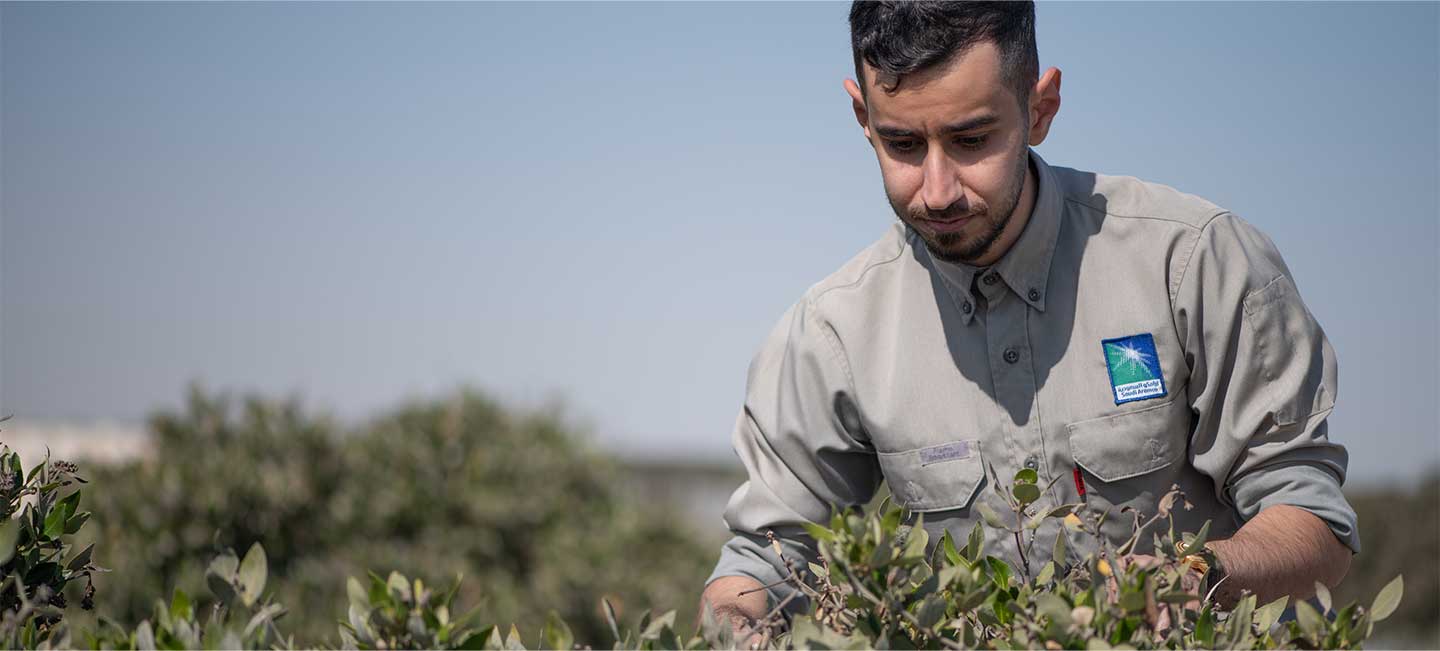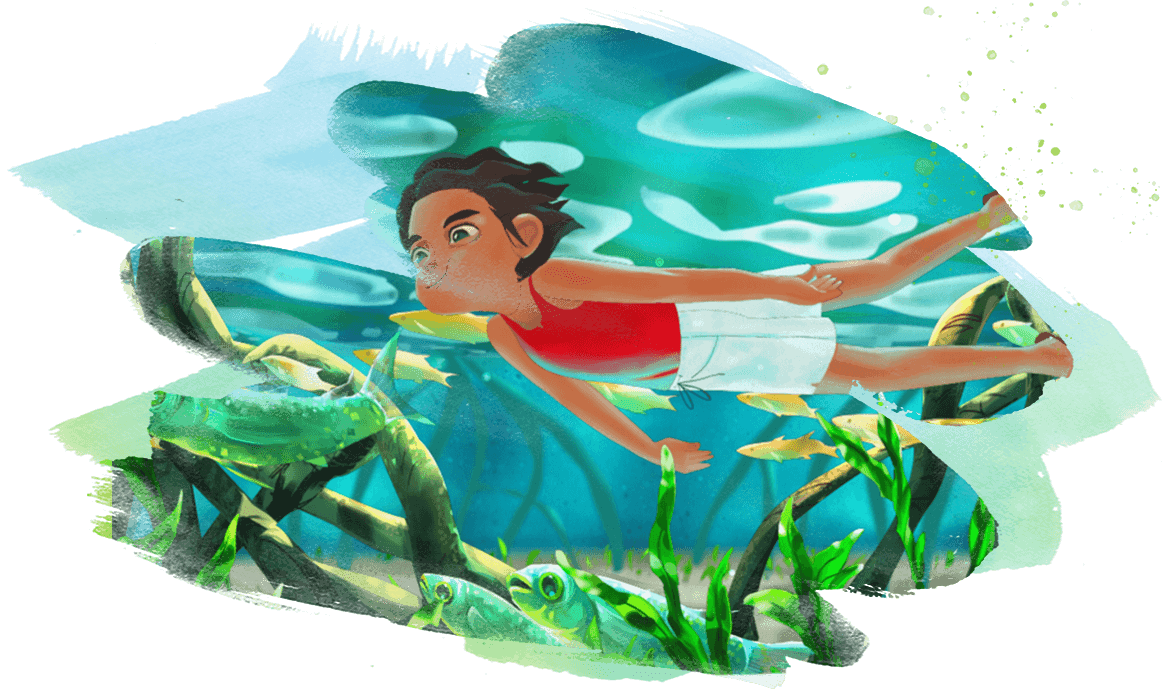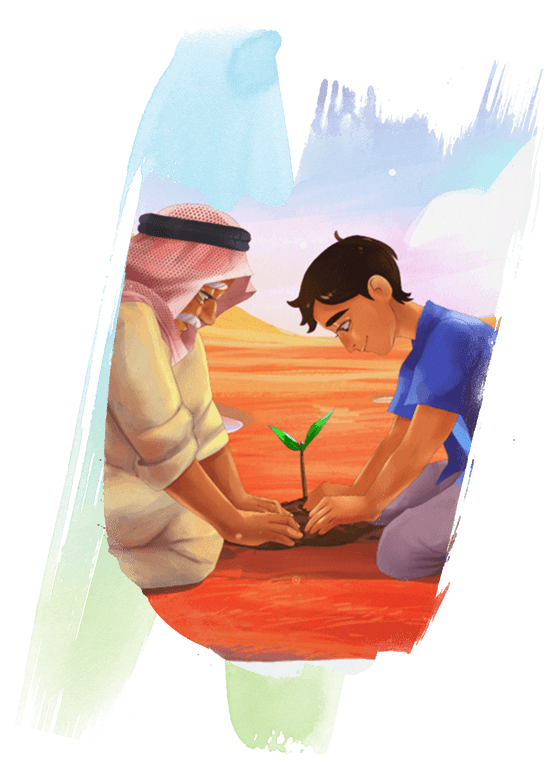Real stories inspire — Seeding tomorrow
Hassan grew up exploring the mangrove forests along the shores of the Kingdom’s Eastern Province. He has since dedicated his professional life to replanting and protecting them.

- As a young boy, Hassan and his Uncle Jamal used to enjoy the mangrove forests around Tarout Bay
- Over the years, the biodiversity in this region, which historically relied on fishing, began to decline
- Hassan now is part of the Green Energy Program Team at Aramco, and supported the program to plant mangroves. There are 63 km2 of mangrove forest, and millions of mangroves planted, as a result

Mangroves are a special kind of tropical tree, which thrive in warm coastal areas, where they form rambling, labyrinthian estuaries, which act as buffers between land and sea. These hardy plants subsist on brackish water that’s too salty for any other timber to tolerate. As they grow, their meandering roots stabilize the sediment and filter the water; when enough of them flourish, the resulting thickets shield the shoreline from winds, waves, and tidal floods.
Mangroves also create a kind of insular ecosystem, which serves as an underwater nursery — a place where juvenile fish and shrimp can grow in relative security before venturing out into the open ocean.
When Hassan was growing up, these forests provided a nurturing refuge for him, too. As a boy, he remembers visiting them with his Uncle Jamal, watching leggy herons stalk the muddy banks, and listening to the chirpy whistle-song of reed warblers.
Sadly, as Hassan reached adulthood, many of the mangrove forests that had once prospered near his hometown had all but vanished.

Illustration from Hassan’s story - A young Hassan swims with the fish
“I grew up with the mangrove trees, which are one of the natural wonders of the Kingdom. As an adult, I realized they are important for life, for example, a home for birds, fish, shrimps, and many other species,” he says.
Historically, fishing was the main source of income in this region of Saudi Arabia. And since mangroves offer an essential marine crèche, their decline has meant that the numbers and biodiversity of local fish have suffered.
“I grew up in Tarout Bay; my family and the community have been relying on these mangroves for generations to support their livelihood…[the] mangroves are part of our cultural heritage and identity,” says Hassan.
“It’s like my Uncle Jamal always said, that ‘the need to protect our beautiful land is a duty more than a choice,’” he adds.

A child of Al Qatif, a city on the eastern shores of the Arabian Gulf, Hassan was intimately familiar with the importance of mangrove habitats. Having witnessed these forests’ deterioration firsthand, he felt determined to do something about it.
After studying industrial hygiene in the US, Hassan returned to Saudi Arabia. He now works at Aramco as an Industrial Hygienist, supporting its Green Energy Program Team.
“When I joined Environmental Protection in Aramco, I was interested in the mangrove protection and plantation programs being conducted by the company,” he says. “In the Green Energy Program, I’ve been tasked with the development of nature-based solutions involving forestry—particularly mangroves.”
After joining Aramco, one of the first things Hassan did was work on the program to plant mangroves across the Kingdom. There are 63 km2 of mangrove forest, salt marsh and seagrass habitats that are protected as a result of this work. These efforts, he emphasizes, are about more than trees.
“We need to protect biodiversity not only to conserve the mangroves. The local species of birds, fish, shrimps, and tortoises rely on them, as do migratory birds, which travel thousands of kilometers every year to feed in these habitats.,” Hassan adds.
“My family and the community have been relying on these mangroves for hundreds of generations to support their livelihood…[the] mangroves are part of our cultural heritage and identity.”
Hassan, Mangroves grower


Yet protecting Saudi Arabia’s biodiversity doesn’t have a one-size-fits-all solution. As Hassan points out, different regions of the Kingdom require distinct effort.
“In the Eastern Province, mangrove restoration is required because many mangrove habitats have been lost. Whereas, in the Western region of the Kingdom, along the Red Sea, mangrove habitats are abundant, but still need on-going protection.”
All told, in the decades since these initiatives began, the company has planted millions of mangrove seedlings.
“A lot of my day-to-day work involves looking for new potential mangrove plantation areas in the Kingdom, as well as documenting existing mangrove forests, as part of the Green Energy Program [at Aramco]. In addition, we also spend a lot of time developing programs for additional plantation efforts that would enhance biodiversity and support carbon capture and storage. And we follow up on and monitor the success of existing projects.”
So far, Hassan says the results of these initiatives have been promising. On Abu Ali Island, the team planted fewer than 100 mangroves initially. Since then, these plants have multiplied prolifically, resulting in a large, flourishing forest.
Hassan also says that his efforts aren’t limited to Saudi Arabia. In 2018, Aramco sponsored the protection of mangroves on Haimen Island, in Southeast China’s Fujian Province.
Seeing these kinds of results, he says, energizes him to press on.

The other motivator, according to Hassan, are the many young people who volunteer to help rejuvenate and protect the Kingdom’s mangrove forests.
“There is a huge number of active community volunteers that take part in mangrove clean up and plantation programs,” says Hassan. “I want to pass on my knowledge, experience, and passion to these young people, who are the future of this program.
The young generations are very aware and active in relation to the environment. They have been enthusiastically participating in this program, in part, I think, because they can see the long-term benefits of their efforts.”
Thanks to Hassan’s efforts, future generations will enjoy the natural splendor of vibrant mangrove ecosystems — as well as the bounty they produce — just like he did when he was a child.
ELEMENTS
